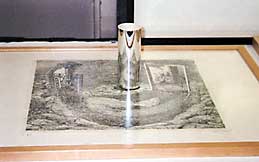
The Mathematical Art Exhibition
A special Mathematical Art Exhibit was on view throughout much of the Joint Mathematics Meetings in Phoenix. The exhibit, located in a room of the Phoenix Civic Center, was organized by Robert Fathauer (Tessellations Company, Phoenix), Nat Friedman (ISAMA, SUNY at Albany), and Reza Sarhangi (Bridges Conference, Towson University).
 |  |
 |  |
"On display are paintings, prints (both digital and traditional), and sculpture by artists whose work is inspired by mathematics and by mathematicians who use visual art to express their findings. The artworks draw on a range of mathematical topics, including fractals, symmetry and tiling, topology, and polyhedra. Optical illusions, unusual perspective systems, and anamorphosis are employed in several of the works," described the organizers. An original print by M.C. Escher ("Fish and Scales") was also on display in the exhibit.
Participating artists and mathematicians:
- Brent Collins, professional artist based in Missouri
- Hollister David, publisher of a local newspaper in Ajo, Arizona, who also creates paintings based on tilings and polyhedra
- Robert Fathauer, professor of Electrical Engineering, Arizona State University, who produces tiling and fractal-based prints, and owns Tessellations Co., a small business that produces tiling puzzles
- Michael Field, professor of Mathematics, University of Houston, who uses computers to create intricate prints employing different types of symmetry
- Nat Friedman, professor of Mathematics, State University of New York at Albany, who explores sculpture in a variety of media
- George W. Hart, professor of Computer Science at Stony Brook University, who creates polyhedra-based sculpture in a variety of media
- Kerry Mitchell, computer scientist based in Arizona, who creates fractal prints
- Istvan Orosz, professional artist based in Budapest, who uses traditional printmaking techniques to produce works based on optical illusions and anamorphosis
- Carlo Sequin, professor of Computer Science, University of California, Berkeley, who creates mathematical sculpture using computer-aided tools
- Dick Termes, professional artist based in South Dakota, who paints on spheres and polyhedra using a six-point perspective system he devised
More highlights of the 2004 Joint Mathematics Meetings

